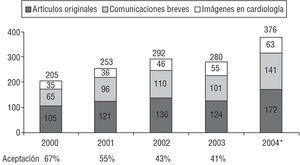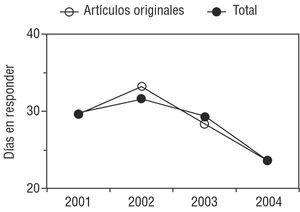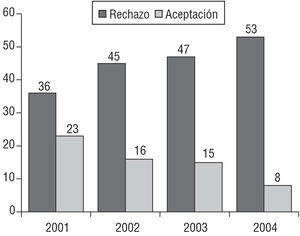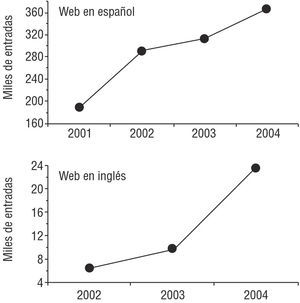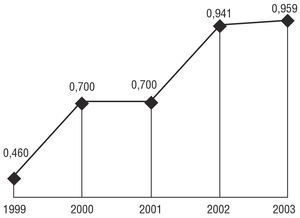At the Congress on Cardiovascular Diseases held in Madrid in October, 2004, we informed the Board of Directors of the Spanish Society of Cardiology (SSC) and the General Assembly of members about the journal's recent activities. In addition we held our annual meeting with the Editorial and Advisory Committees of Revista Española de Cardiología.
At this meeting we presented detailed data on the activities carried out in 2004 and on new guidelines adopted recently, and engaged in an interesting exchange of views regarding editorial policies and potentially useful future strategies. Here we summarize for all our readers the most relevant information on how the journal and our editorial policies have developed.1-4
ARTICLES RECEIVED, REVIEWS, AND TIME TO PUBLICATION
During 2004 we received for review a total of 376 articles, representing a 34% increase with respect to 2003. As Figure 1 shows, the increase was similar for all types of article (Original Articles, Brief Reports, and Images in Cardiology), confirming the trend of the last few years. The number of manuscripts submitted from other countries increased from 51 in 2003 to 70 in 2004. The largest proportions of manuscripts were from Mexico (39%) and Argentina (20%). The number of manuscripts received in English also increased from 6 in 2002 to 9 in 2003, and to 14 in 2004.
Figure 1. Changes in the number of manuscripts received and percentage acceptance rates. *Fourth trimester data based on best estimate.
Because of measures taken to try to reduce the time to decision on manuscripts, we achieved a substantial improvement in time to receipt of the reviewers' reports (mean 23 days, median 21 days) (Figure 2), and thus approached our ambitious but reasonable goal of receiving reviewers' reports within 2 weeks. It is important to recognize here the efforts of all members of the Editorial Committee to complete their excellent reviews within this short timeline. Their critiques and comments are decisive not only because they aid us in the increasingly difficult task of choosing manuscripts for publication, but also because they also help to improve the scientific quality of those papers we eventually do publish. Especially worthy of mention is the work of those serve as advisors to Revista Española de Cardiología; although they are not members of the Editorial Committee, they have provided generous assistance with their excellent reviews (Table 1). The Editors wish to take this opportunity to offer our express appreciation for their invaluable help.
Figure 2. Changes in mean time to receipt of reviewers' reports.
Another aspect we found interesting is that reviewers' reports are becoming more detailed and rigorous. Figure 3 shows how reviewers' recommendations have changed during the last few years. It is clear that the number of original articles initially accepted has declined, and that the number of reviews recommending rejection has increased. These increasingly critical reports may be nothing more than a reflection of the widely-held perception that the credibility and quality of Revista Española de Cardiología are on the rise.1-4 As a result, only the best articles are being recommended for acceptance from among an increasingly large pool of submissions.
Figure 3.Changes in reviewers´ recommendations for original articles. "Reject" indicates that after the first round of review, both reviewers recommended rejection or one recommended rejection and one requested major changes. "Accept" indicates that after the first round of review, both reviewers recommended acceptance or minor changes.
At the editorial office in the Casa del Corazón in Madrid, Spain, an additional motive for satisfaction has been the time to publication achieved during 2004. The period from manuscript receipt to publication has decreased significantly from 11.3 months in 2003 to 8.1 months for original articles published during 2004. Prompt publication of original articles is one of the variables that researchers notice most when they choose which journal to submit their results to. We can therefore say with some pride that our current publication times are similar to, and in many cases lower than, those offered by the most prestigious international publications considered leaders in the area of cardiovascular research. Accordingly, we will sustain our efforts to ensure that our authors continue to benefit from this prompt publication time.
PRIZES AND SUPPLEMENTS
We have expanded our policy of awarding prizes for the best articles published in the journal (Table 2). In addition to the prizes awarded by the journal for the best articles published with the greatest medium-term and long-term international impact, additional prizes have been created by different scientific sections of the SSC for articles dealing with specific areas of interest. In all, 18 different prizes worth a total of 50 778 euros are now being awarded in 9 different areas.
There has also been a notable increase in the number of supplements. During 2004 a total of 9 appeared (compared to 5 in 2002 and 6 in 2003). Two of them (abstracts presented at the SSC annual congress and the Joint Symposium of the American Heart Association, the SSC and the Interamerican Society of Cardiology) appeared as issues of Revista Española de Cardiología; the other 7 supplements were published as Revista Española de Cardiología Suplementos. The number of articles published in these supplements has also increased exponentially from 7 in 2000 to 52 during 2004.
DISSEMINATION
It is important to draw attention to the increased dissemination of Revista Española de Cardiología, achieved mainly through its two electronic editions. Figure 4 shows the trends in the number of visitors to our Spanish and English websites. Of particular interest is the 130% increase (in comparison to 2003) in visitors to our on-line English-language edition during 2004. The number of complete articles downloaded in pdf format has also increased significantly. In 2004 a total of 8900 articles in English were downloaded--a 117% increase compared to the 4100 complete articles in English downloaded in 2003. It is clear then that at this time the greater dissemination and internationalization of our journal are fomented by our electronic editions, and particularly by our on-line English-language edition.
Figure 4. Numbers of visitors to Spanish and English websites in recent years. (The English website first appeared in 2002.)
BIBLIOMETRIC ASPECTS
The year 2004 saw a further improvement in our impact factor (Figure 5). Our current impact factor of 0.959 means that on average, during 2003 almost every article published in the journal in 2001 and 2002 was cited once. This increase confirms that RevistA Española de Cardiología is becoming consolidated as the leading publication on cardiovascular disease in Spanish. Indeed, it now has the second-highest impact factor of all medical journals published in Spanish. Moreover, its immediacy index (citations received during the same year) for 2004 was 0.47.
Figure 5. The impact factor for Revista Española de Cardiología.
The impact factor is a simple index obtained by dividing the number of citations to published articles by the number of articles published, so it cannot be expected to evaluate all features that go into a journal's quality, credibility and scientific impact.5 In fact, this parameter has been found to have as many as 19 limitations in its ability to reflect important aspects of a publication's quality and scientific impact.6 Curiously, although this indicator is widely accepted, we have been surprised at how little authors and even some members of the Editorial Committee know about how it is calculated. This makes it important to recall here that the impact factor for 2004 will be calculated as the total number of citations during that year to articles published in Revista Española de Cardiología during the years 2002 and 2003, divided by the total number of articles published in the journal during 2002 and 2003. Thus the importance of citing very recent articles (published in the last 2 years) in new research articles with a view to increasing this popular bibliometric indicator.
NEW EDITORIAL POLICIES
This year we have made changes to adapt our policies to the most recent recommendations of the International Committee of Medical Journal Editors (ICMJE, better known as the Vancouver Group). In the current recommendations technical aspects have been resolved for the most part, and the latest update centers mainly on newer issues of editorial ethics.7,8 During the summer of 2004 the ICMJE examined an interesting issue raised by the suggestion that all clinical trials should be registered from the start in a specific registry that fulfills standard requirements for quality, accessibility and independence.9,10 The ultimate aim is for the availability of scientific information not to be conditioned by the biases that work in favor of publication of studies that yield positive results. Approval in Spain of new laws regarding clinical trials, necessary in part to adapt our national legislation to the current European Directive, is a step in the same direction. At Revista Española de Cardiología we have been following the debate closely in order to modify editorial policies as necessary to take these new issues into account in an appropriate manner.
One more new feature introduced recently in Revista Española de Cardiología is the section called Clinical Practice Guidelines of the European Society.11 Since October 2004 we have published 4 such guidelines. In a world that is also globalized in scientific terms, we feel that publication of these guidelines in our journal will help to enhance their dissemination to all health professionals devoted to the study of cardiovascular diseases.
Correspondence: Revista Española de Cardiología.
Sociedad Española de Cardiología.
Nuestra Señora de Guadalupe, 5-7. 28028 Madrid. España.
E-mail: rec@revespcardiol.org
